Argentan
| Argentan | ||
|---|---|---|
|
The Château of the dukes in the center of Argentan. | ||
| ||
 Argentan | ||
|
Location within Normandy region  Argentan | ||
| Coordinates: 48°45′N 0°01′W / 48.75°N 0.02°WCoordinates: 48°45′N 0°01′W / 48.75°N 0.02°W | ||
| Country | France | |
| Region | Normandy | |
| Department | Orne | |
| Arrondissement | Argentan | |
| Canton | 2 cantons | |
| Intercommunality | Pays d'Argentan | |
| Government | ||
| • Mayor (2008–2014) | Pierre Pavis | |
| Area1 | 18.18 km2 (7.02 sq mi) | |
| Population (2012)2 | 14,219 | |
| • Density | 780/km2 (2,000/sq mi) | |
| Time zone | CET (UTC+1) | |
| • Summer (DST) | CEST (UTC+2) | |
| INSEE/Postal code | 61006 / 61200 | |
| Elevation | 152–228 m (499–748 ft) | |
|
1 French Land Register data, which excludes lakes, ponds, glaciers > 1 km² (0.386 sq mi or 247 acres) and river estuaries. 2 Population without double counting: residents of multiple communes (e.g., students and military personnel) only counted once. | ||
Argentan (French pronunciation: [aʁʒɑ̃tɑ̃]) is a commune and the seat of two cantons and of an arrondissement in the Orne department in northwestern France.
Argentan is located 180 km (110 mi) NE of Rennes, 131 km (81 mi) ENE of the Mont Saint-Michel, 188 km (117 mi) SE of Cherbourg, 58 km (36 mi) SSE of Caen, 133 km (83 mi) SW of Rouen and 100 km (62 mi) N of Le Mans.
History
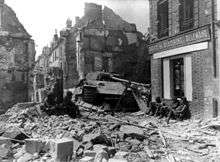
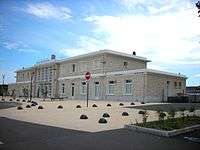
Argentan is situated near the Orne River. Although the region was heavily populated during the Gallo Roman period the town is not mentioned until 1025–1026. The toponym comes from the Gaulois words, argentos (silver) and magos (market).[1] The town grew in importance during the Middle Ages.
Following the Viking invasion on the coast of northern France, the north-western part of Neustria became Normandy (literally: Northman country). The Viking chief, Rollo, left the town to one of his lieutenants. Throughout the Middle Ages, Argentan was either a rich place or totally burnt. English forces occupied the city several times. The Plantagenet had considered this town as one of the most important of Normandy.
During the reign of Louis XIV, Colbert set Alençon against Argentan in an economic competition on lace making. Thus, the point d'Argentan ("Argentan stitch") and the point d'Alençon ("Alençon stitch") were created. Argentan became a very important town for traditional industry. It also gained in religious importance with the building of a Benedictine Abbey and two churches, Saint-Martin and Saint-Germain. Several mansions (hôtels particuliers) were also built.
During World War I, the French 104th Infantry Regiment/14th Infantry Brigade was stationed at Argentan. It participated in the battle of Verdun in 1916.
During World War II, the city was almost totally destroyed. On 5 June 1944, on the eve of the Allied D-Day landing on the beaches of Normandy, the city suffered an important air raid in which the train station was destroyed.[2] The city suffered further damage when it was bombed on 6 and 7 June by B-17 and B-24 bombers of the U.S. Eighth Air Force.[3] The greatest part of the city was, however, left in ruins two and half months later, at the end of August, during the battle of the Argentan-Falaise Pocket. The U.S. Third Army, under the command of general George S. Patton liberated Argentan after eight days of violent combat against the German 9th Panzer Division and the 2nd SS Panzer Division Das Reich. The U.S. 80th Infantry Division liberated the city in the morning of 20 August. The city was burning.
Population
| Historical population | ||
|---|---|---|
| Year | Pop. | ±% |
| 1793 | 5,598 | — |
| 1800 | 5,618 | +0.4% |
| 1806 | 6,013 | +7.0% |
| 1821 | 5,457 | −9.2% |
| 1836 | 5,772 | +5.8% |
| 1841 | 5,611 | −2.8% |
| 1846 | 5,634 | +0.4% |
| 1851 | 5,673 | +0.7% |
| 1856 | 5,833 | +2.8% |
| 1861 | 5,638 | −3.3% |
| 1866 | 5,401 | −4.2% |
| 1872 | 5,725 | +6.0% |
| 1876 | 5,788 | +1.1% |
| 1881 | 6,300 | +8.8% |
| 1886 | 6,285 | −0.2% |
| 1891 | 6,247 | −0.6% |
| 1896 | 6,309 | +1.0% |
| 1901 | 6,291 | −0.3% |
| 1906 | 6,387 | +1.5% |
| 1911 | 6,870 | +7.6% |
| 1921 | 6,753 | −1.7% |
| 1926 | 7,129 | +5.6% |
| 1931 | 7,038 | −1.3% |
| 1936 | 7,204 | +2.4% |
| 1946 | 6,711 | −6.8% |
| 1954 | 8,339 | +24.3% |
| 1962 | 12,757 | +53.0% |
| 1968 | 14,558 | +14.1% |
| 1975 | 16,774 | +15.2% |
| 1982 | 17,327 | +3.3% |
| 1990 | 16,413 | −5.3% |
| 1999 | 16,596 | +1.1% |
| 2006 | 14,900 | −10.2% |
| 2008 | 14,439 | −3.1% |
| 2012 | 14,219 | −1.5% |
Main sights
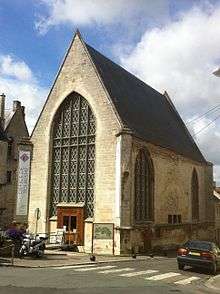 Chapel Saint Nicholas - built end of the 11th century |
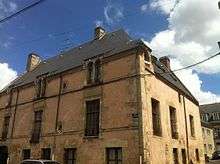 Hôtel du Moulin de Tercey, 2 rue Saint-Martin |
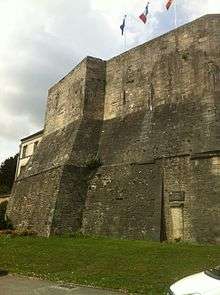 Donjon of Argentan, built by Henry II of England |
 St Germain church and weekly market. Market days are Tuesday,Friday, and a small one on Sunday morning. Church built 16th-18th century. |
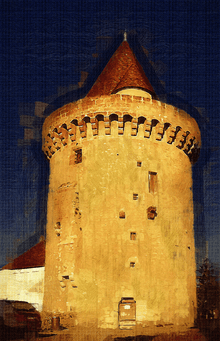 Tour Marguerite is the only surviving medieval tower remaining from the Middle Ages in Argentan. |
 St.Martin church built in the 15th and 16th centuries |
 Vestige of Henry II of England's donjon or castle keep built in the 12th century. |
 Hotel Joseph de Laleu 56 rue Saint Martin built in 1651 |
 This hotel particulier was the Nicolas Ango house, built by an up-and-coming bourgeois. |
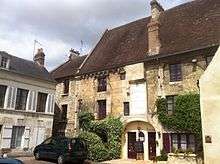 Abbaye in Argentan now a restaurant |
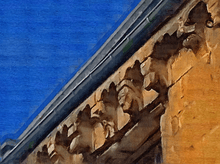 Faces on the old former abbey in the Romanesque style. |
.png) Château of the Dukes of Alençon, but functioning as the Court House (Palais de la Justice) |
_Painter_decorator._cofounder_with_Louis_SUE_de_la_Compagnie_the_Arts_Fran%C3%A7aisue_de_Prison.jpg) Birthplace of André Mare (1885-1935) Painter and decorator. Cofounder, with Louis SÛE, of the Compagnie the Arts Française. Corner of rue de la Vieille Prison and rue Pierre Ozenne. |
 One of a number of Hotel Particulaires, or private homes, from the 17th century. Rue St.Martin |
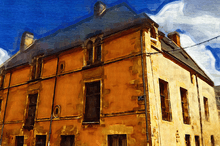 Hotel particulaire rue St.Martin and rue Pierre Ozenne |
- Donjon of Argentan
- Tour Marguerite, a medieval tower
- Ducal Castle (14th century), now a Court House. It houses the St. Nicholas Chapels (late 11th century), built by Pierre II of Alençon
- Saint Martin church (15th–16th centuries)
- Saint Germain church (16th–18th centuries)
- Saint Roch Chapel
- Museum of the Argentan lace
Personalities
Argentan was the birthplace of:
- Giles d'Argentan (c. 1280 – 24 June 1314), Norman knight who was killed at the Battle of Bannockburn
- François-Eudes de Mézeray (1610–1683), historian
- Fernand Léger, painter
- André Mare (1885–1935), painter
- Michel Onfray (born January 1, 1959), philosopher
International relations
Argentan is twinned with:
See also
References
- ↑ MOULIN, Marie-Anne; CHAVE, Isabelle; FAJAL, Bruno; FOUCHER, Jean-Pascal; et al. (2008). Argentn et ses environs au Moyen Âge: Approche historique et archéologique. Public Library: Conseil général de l'Orne. p. 38. ISBN 978-2-86061-032-2.
- ↑ Destruction of Argentan SNCF train station in August 1944: http://argentan.vapeur.free.fr/gare_guerre.html (French site)
- ↑ Freeman, Roger A., The Mighty Eighth, Motorbooks International, 1981, 1990, pp. 259 & 260.
- ↑ "British towns twinned with French towns". Archant Community Media Ltd. Retrieved 2013-07-11.
External links
| Wikimedia Commons has media related to Argentan. |
- Official site
- {https://web.archive.org/web/20110711022230/http://www.france-horizons.com/Normandie/61-Orne/Argentan/fr/tourisme-argentan.html Tourism site]
.svg.png)